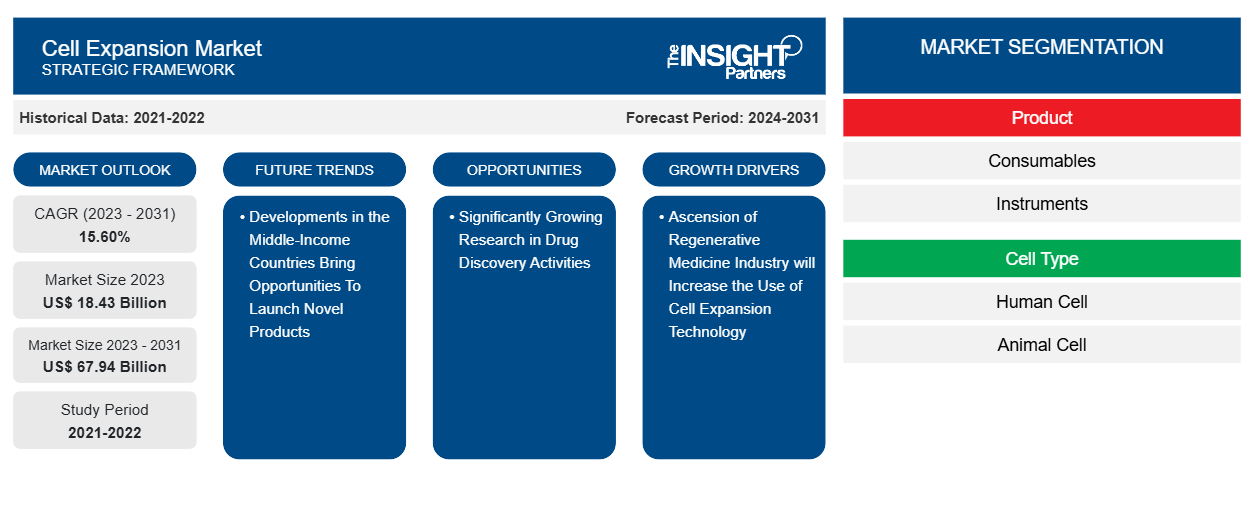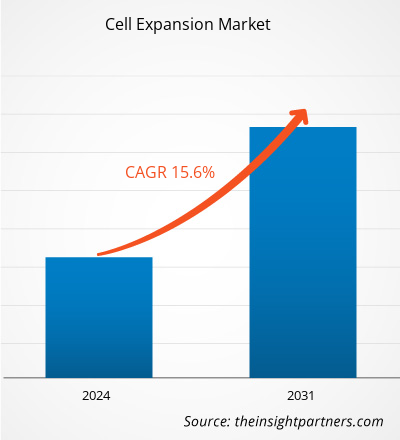The Cell Expansion Market size is projected to reach US$ 67.94 billion by 2031 from US$ 18.43 billion in 2023. The market is expected to register a CAGR of 15.60% in 2023–2031. The significantly growing research in drug discovery activities are likely to remain a key cell expansion market trend.
Cell Expansion Market Analysis
Cell expansion is an important and invariable part of regenerative medicine. On the basis of study and investigation, desired regeneration techniques involve cell expansion procedures to develop the tissue. It helps to understand how to treat injuries and diseases from broken bones to neurodegenerative diseases. Advancements in regenerative medicine industry, and rising demand for cell-based therapies is expected to boost the Cell Expansion market growth over the forecast period.
Cell Expansion Market Overview
Cell expansion is an important technology widely utilized in stem cell and regeneration medicine. Cell development has multiple potential applications that include drug testing and development, development of cell-based therapy, cancer tissue research and others. The rising prevalence of chronic diseases cancers, cardiovascular disorders fuel the demand of cell expansion technologies which boosts the growth of the Cell Expansion market.
Customize This Report To Suit Your Requirement
You will get customization on any report - free of charge - including parts of this report, or country-level analysis, Excel Data pack, as well as avail great offers and discounts for start-ups & universities
Cell Expansion Market: Strategic Insights

-
Get Top Key Market Trends of this report.This FREE sample will include data analysis, ranging from market trends to estimates and forecasts.
Cell Expansion Market Drivers and Opportunities
Ascension of Regenerative Medicine Industry to Favor Market
Cell expansion is a fundamental technology in research and development in regenerative medicine. Regenerative medicine utilizes the current methods and research to revive and replace dead or damaged tissue with the use of stem cells, including embryonic, adult, and induced pluripotent stem cells (iPS). Stem cells have a central role in the generating therapeutic cells and personalized medicine.
Additionally, various initiatives undertaken at the international level to increase the use of stem cells for regenerative medicine contributes to the growth of regenerative medicine industry. Japan and UK initiated a program named the UK-Japan Regenerative Medicine and Stem Cell Research Initiative that aims at providing funding for nearly eight collaborative research projects that build upon fundamental insights and initial early-stage discoveries to advance regenerative approaches towards clinical use in the future and to utilize stem cells as medical research tools.
Developments in the Middle-Income Countries
The emerging markets in the developing countries are creating better opportunities for significant market players to expand their business. Most of the major players focus on emerging markets including India, China, Australia among others owing to large number of chronic diseases such as cancer and growing medical tourism in developing countries. Many of the emerging countries are facilitated with high technology-based research facilities and advanced life science studies.
Cell Expansion Market Report Segmentation Analysis
Key segments that contributed to the derivation of the Cell Expansion market analysis are product, cell type, application, and end user.
- Based on product, the cell expansion market is divided into consumables and instruments. The consumables segment held a larger market share in 2023.
- Based on cell type, the market is bifurcated into human cell and animal cell. The human cell segment held a larger market share in 2023.
- In terms of application, the market is segmented into regenerative medicine & stem cell research, cancer and cell-based research, and other applications. The regenerative medicine & stem cell research segment dominated the market in 2023.
Cell Expansion Market Share Analysis by Geography
The geographic scope of the Cell Expansion market report is mainly divided into five regions: North America, Asia Pacific, Europe, Middle East & Africa, and South & Central America.
In North America, the market is currently in the growth phase and experiencing exponential growth. The rising prevalence of chronic and congenital medical conditions, coupled with the availability of research funding, are expected to fuel the cell expansion market growth. In the US several initiatives in the field of stem cell therapies have been taken. The stem cell gene therapy can be used for treating various chronic and rare disorders. For instance, the stem cell gene therapy developed by UCLA researchers provides a cure for babies born with severe combined immunodeficiency (SCID) associated with adenosine deaminase (ADA) deficiency, which is a rare and life-threatening condition that can prove to be fatal within the first year of life, if left untreated.
Cell Expansion Market Regional Insights
The regional trends and factors influencing the Cell Expansion Market throughout the forecast period have been thoroughly explained by the analysts at The Insight Partners. This section also discusses Cell Expansion Market segments and geography across North America, Europe, Asia Pacific, Middle East and Africa, and South and Central America.
Cell Expansion Market Report Scope
| Report Attribute | Details |
|---|---|
| Market size in 2023 | US$ 18.43 Billion |
| Market Size by 2031 | US$ 67.94 Billion |
| Global CAGR (2023 - 2031) | 15.60% |
| Historical Data | 2021-2022 |
| Forecast period | 2024-2031 |
| Segments Covered |
By Product
|
| Regions and Countries Covered |
North America
|
| Market leaders and key company profiles |
|
Cell Expansion Market Players Density: Understanding Its Impact on Business Dynamics
The Cell Expansion Market is growing rapidly, driven by increasing end-user demand due to factors such as evolving consumer preferences, technological advancements, and greater awareness of the product's benefits. As demand rises, businesses are expanding their offerings, innovating to meet consumer needs, and capitalizing on emerging trends, which further fuels market growth.

- Get the Cell Expansion Market top key players overview
Cell Expansion Market News and Recent Developments
The Cell Expansion market is evaluated by gathering qualitative and quantitative data post primary and secondary research, which includes important corporate publications, association data, and databases. The following is a list of developments in the market for innovations, business expansion, and strategies:
- In May 2023, Akadeum launched new products for cell therapy research and development that enable direct leukopak human immune cell isolation and T-cell activation/expansion kits at the American Society of Gene + Cell Therapy’s 26th Annual Meeting held in Los Angeles from May 16-20, 2023. These products expand company’s lineup of BACS Microbubble buoyancy-based cell isolation kits, allowing researchers to directly isolate T cells and peripheral blood mononuclear cells from leukapheresis material, without the need for lysis or density gradient centrifugation. (Source: Akadeum Life Sciences, Press Release)
- In September 2022, Terumo Blood and Cell Technologies (Terumo BCT) launched Quantum Flex Cell Expansion System, a bioreactor platform that supports process development through to commercial manufacturing for the cell and gene therapy (CGT) sector. Quantum Flex provides earlier automation, enabling developers to complete their early process development on the same platform they will use for manufacturing. This reduces cost and risk of unanticipated process deviations in later phases of clinical trials. (Source: Terumo Blood and Cell Technologies, Newsletter)
Cell Expansion Market Report Coverage and Deliverables
The “Cell Expansion Market Size and Forecast (2021–2031)” report provides a detailed analysis of the market covering the following areas:
- Cell Expansion Market size and forecast at global, regional, and country levels for all the key market segments covered under the scope
- Market dynamics such as drivers, restraints, and key opportunities
- Cell Expansion Market trends
- Detailed PEST and SWOT analysis
- Cell Expansion market analysis covering key market trends, Global and regional framework, major players, regulations, and recent market developments
- Cell Expansion Industry landscape and competition analysis covering market concentration, heat map analysis, prominent players, and recent developments
- Detailed company profiles
- Historical Analysis (2 Years), Base Year, Forecast (7 Years) with CAGR
- PEST and SWOT Analysis
- Market Size Value / Volume - Global, Regional, Country
- Industry and Competitive Landscape
- Excel Dataset
Recent Reports
Related Reports
Testimonials
Reason to Buy
- Informed Decision-Making
- Understanding Market Dynamics
- Competitive Analysis
- Identifying Emerging Markets
- Customer Insights
- Market Forecasts
- Risk Mitigation
- Boosting Operational Efficiency
- Strategic Planning
- Investment Justification
- Tracking Industry Innovations
- Aligning with Regulatory Trends





















 Get Free Sample For
Get Free Sample For